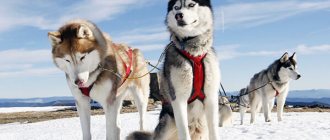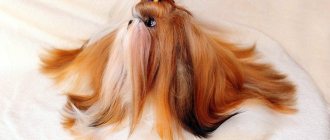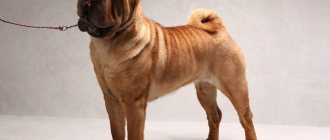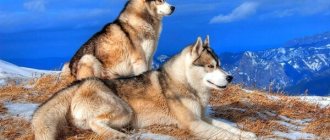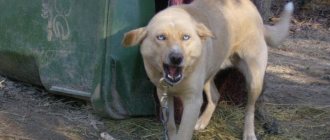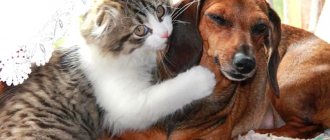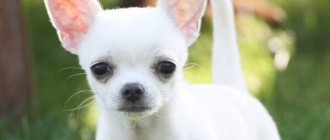Siberian Huskies have captured the imagination of ordinary people and have also attracted the attention of artists, writers and film producers. This small sized service dog has stamina and athleticism. The biggest criticism of the breed is their reputation as runaways. The dog, which looks similar to a wolf, German shepherd and husky, is distinguished by its incredible desire for adventure and willful character. The Husky dog loves space, it needs long walks in the fresh air and feasible physical work. Lying on the sofa, the pet begins to “lose its head.” Only high endurance and leadership qualities will help raise an impeccable “snow dog.”
Siberian Husky
History of the origin of the breed
The Siberian Husky has been living with humans for several centuries. Bred in cold climatic conditions in the Far North. Local residents needed a dog that could easily cover long distances and transport people and cargo. The formation of the husky's character was greatly influenced by regional climate conditions with fairly low temperatures. Under their influence, the structure of the animal was formed.
Since the 20th century, there has been an active spread of representatives of the breed throughout the world. Residents of the American continent appreciated such qualities of their four-legged friend as agility and the ability to walk harmoniously and be the leader of the team.
Alaskan mushers needed dogs for sled dog racing. The legendary husky Togo, in the team of Leonard Seppala, did not give up the championship for many years in a row. However, he gained fame for completely different merits.
In 1925, a dog relay race was held, during which Leonard Seppala's team, led by Togo, covered a long section of the route and reached a small town in Alaska. The inhabitants of Nome were exposed to a fatal disease, and the dog Togo, with other dogs in the sled, delivered them anti-diphtheria serum. Thanks to him, residents received a chance for recovery.
At that time, getting to the small town was completely problematic, since natural conditions did not allow it. The leader of the pack with his faithful dogs covered 146 km of the road, 80 km of which they walked on the ice of Norton Bay in severe frost conditions of -400, with a strong snowstorm. Togo's endurance, courage, and instincts helped the team reach the town of Noma and help people.
Since huskies were sled dogs, their further selection was carried out in America; in our country, sled dogs were considered unpromising.
In the USA, as a result of crossing aboriginal sled dogs with huskies, mixed-breed pets appeared that surpassed huskies in racing competitions. However, the developed dog breed was not recognized by international organizations, since the varieties were of different types.
In the 70s, dogs were presented at exhibitions. L.Demidoff and E.Sili convinced people that a bright dog with blue eyes is suitable for keeping in an apartment, as it is a companion dog.
In the 90s, the husky returned to Russia, its historical homeland. In 1995, the first dogs were brought from the Czech Republic and Belgium. By 2000, the number of husky puppies increased to 150 individuals.
How to feel about loneliness
They are sociable dogs that have lived in packs throughout their history, so they need constant interaction with people and other animals.
You cannot limit the communication of huskies and isolate them . Spending a long time alone has a negative impact on the health and mental state of these dogs.
Appearance of the Husky breed
The Siberian Husky is a sled dog that was bred to work. Fluffy dogs in the frosty north had to pull a team with a person and luggage over long distances. As time passed, the American standard changed its reference point from working to exhibition. The Husky was considered a show dog. People are often attracted by the appearance of these beautiful, majestic dogs. And this is not surprising - with their wolf-like features, thick, soft fur and blue or multi-colored eyes, huskies are sure to attract the attention of any passerby.
Size and weight
The animals are of medium size. A male at the withers reaches 54–60 cm and weighs 21–28 kg, a female – 51–56, weighing 16–23 kg. If a dog's height exceeds the acceptable guidelines, it may be disqualified.
A husky's weight and height are directly proportional. If you look at the dog from the side, then the length of its body should exceed the height at the withers.
Husky color and coat type
Color ranges from pure white to pure black.
The official colors of the Siberian Husky are recognized in Russia:
- grey-white;
- black and white;
- brown-white;
- white.
A characteristic feature of the paroda is the white markings on the head, similar to a mask.
The coat is medium length, with a soft and dense undercoat. However, even when creating a drooping effect, it is possible to see the lines of the body. The outer coats should be smooth and straight, not rough and erect. Shaggy, coarse coat can be considered a disadvantage of the breed.
There are no hypoallergenic huskies among the representatives, so petting dogs is not recommended for children with allergies.
Types of Huskies and how to distinguish them
Husky is the general name for sled dogs in various regions, the difference between which lies in the degree of color saturation, the outline and color of the eyes, and the height of the dogs. The emergence of species is associated with places of origin.
Kinds:
- Alaskan. It owes its origin to the border collie, malamute, and shepherd dog. Human friends feel great in severe frost, despite their short fur. By nature they are more gentle and devoted, ideal friends for small children.
- Sakhalin Husky or Sakhalin Laika. Compared to other species, it has long hair. By nature - calm, devoted to people. It has high endurance and strength. Since the dog reaches 70 cm at the withers, it is not bred at home.
- Klee-kai. In 1970, a variety of mini-husky was bred in the United States. Thanks to its height of 33 cm and weight of 7 kg, it is ideal for keeping in a small apartment. Life expectancy is 16 years.
How to distinguish a husky from a malamute?
The Alaskan Malamute and Siberian Husky are characterized by their riding qualities. The first is characterized by strength, the second by speed. The Malamute's powerful body allows it to carry large loads. The dog is calm, unhurried, and rarely speaks. The coat color can be brown, black or gray. The fur is erect and rough. Unlike a husky with blue eyes, the Malamute's eyes are brown, with black eyeliner visible. Weight and height exceed the characteristics of a husky.
Akita, Samoyed, Malamute are similar in body shape, coat color and purpose to Siberian Huskies, but are considered independent breeds.
How to choose a puppy
The optimal age for purchase is 1-1.5 months from birth. At this age, the animal develops its own character and habits that are unique to it, but does not yet have a clearly formed model of behavior. During this period, the dog is easiest to tame and teach the rules of behavior in the house.
There is no recipe for choosing the perfect puppy. Huskies change a lot as they get older. Only an experienced breeder will help you choose the ideal companion, athlete or show winner.
What difficulties can you encounter when buying a puppy of this breed:
- Attention. The baby will demand too much and you need to be prepared for this.
- Care. Puppies need play and frequent feeding. At a young age they will demand your participation.
- Lifestyle. While the dog is small, it needs to be accustomed to the family lifestyle. The distinctive properties of the breed allow him to quickly learn all the rules that exist in the house.
- Character. As the puppy grows, it may surprise you more than once with non-standard behavior. You should be prepared for this.
An adult dog knows how to live with a person and knows how to behave. She has an established character and habits, which means the number of surprises that the owner will encounter is minimal.
Health and illness
Dogs have good endurance and excellent health, but are prone to certain diseases:
- cataract;
- atopic dermatitis;
- diabetes;
- hip dysplasia;
- entropion of the eyelid;
- corneal dystrophy;
- paralysis;
- endocrine diseases;
- glaucoma;
- perianal adenoma;
- testicular tumor.
A native of the northern regions is simply obliged to have excellent health, but this does not mean that the owner should not take care and monitor his condition.
When purchasing a Siberian Husky puppy, it is recommended to carefully read the information about the pet, study the pedigree and ask whether there are any serious genetically transmitted diseases in the family.
Sadly, Siberian Huskies can suffer from epilepsy. The disease cannot be cured, but it is quite possible to reduce the number of attacks if you take proper care of your pet.
It is recommended to carry out vaccinations on time and monitor the intake of vitamin complexes. Only careful monitoring of the dog’s condition can prevent the development of many diseases.
A dog should not be allowed to change its weight dramatically; both weight loss and obesity are harmful to it.
It is recommended to conduct a timely examination of the eyes, ears and teeth of the Siberian Husky dog, and also monitor the condition of the coat. His gait says a lot about his pet's health. If the dog begins to limp, it can be assumed that problems with the musculoskeletal system are beginning as a result of muscle damage.
The dog is a native of the Northern regions, so walks with the dog should be done in cool and shady places.
It is recommended to carry out deworming periodically. If your dog is feeling unwell, it is important to consult a doctor promptly.
Lifespan
Under good conditions and proper care, life expectancy is over 15 years.
How does he treat children?
Huskies are natural nannies. The Chukchi, to whom these dogs owe their appearance, used them to warm children, knowing that they were not in danger.
Representatives of this breed get along well with children - they enjoy playing and babysitting with babies and become very attached to them..
Sometimes this attachment is so strong that dogs do not want to leave the child for a minute and always strive to be close to him, even during sleep.
It is better not to leave a very small child alone with a dog, since a rather large and energetic pet can inadvertently injure the baby.
Character and intelligence
By nature, the Siberian Husky is willful and stubborn. In a hopeless situation, he makes his own decisions. And all this thanks to high intelligence.
Huskies are often called the "runaways" of the dog world and are incredibly adept at escaping. Owners should be vigilant in checking their areas for areas where dogs can escape and ensure they are surrounded by a strong fence.
To overcome the wolf roots and adapt the dog to yourself, you need a strong character; the dog will not obey a weak-willed owner.
Originally used to pull sleds, this athletic breed requires regular exercise to prevent boredom. For those who dream of a calm dog who spends all his time on the couch, a husky is not suitable. The Siberian Husky is constantly moving, so it cannot be confined to 4 walls. If you don't give your dog enough open space, the dog will start to freak out and become unbearable.
Their affectionate nature makes them great with children and other pets.
Almost always, the Siberian Husky is friendly, but when his instincts are “tamed”, the friendship ends. If you don't take your dog out for a walk on time, you can end up with chewed shoes and shabby pillows.
It is not recommended to keep a dog on a leash all the time, however, in order to avoid leaving home, it is still recommended to tie a young dog in the absence of the owners, otherwise the husky may simply go “in the air.”
When kept in an apartment, a puppy can do a lot of mischief, for example, chewing off all the shoes, tearing off the curtains, and rolling up all the carpets on the floor. During walks, dogs dig holes, and this behavior is explained by their origin, because in their homeland they dug up snow in order to spend the night in the resulting holes.
Attitude towards children and others
Husky gets along well with kids. The northern peoples had a tradition of letting a dog into the yurt after the birth of a child, so that it would warm the newborn with its warmth. Siberian Huskies love to play with children and ride them on sleds around the yard; the dogs exhibit protective qualities.
However, you should not leave preschool children with a husky, as the dog’s excessive activity can lead to undesirable consequences and even injury.
Training and education
Socialization will be successful if you start raising your dog from an early age. It is advisable to walk at a time when other couples with dogs are walking along the street, as the husky loves company and is sociable. The Siberian Husky is friendly, treats well not only family members, but also everyone around him, so it is useless to train the dog to guard the territory.
First time dog owners should think carefully before purchasing as Huskies can be very independent and difficult to train.
Special rules have been defined for training representatives. When educating, it is necessary to patiently and persistently demand that the command be followed. It is recommended to move on to teaching a new command only after the dog has mastered the first one. The stubbornness of the dog does not allow the owner to understand whether he has learned his lesson or not.
Huskies cannot be forced to obey unconditionally. She must know what she can do and what she is not allowed to do.
Dogs get along well with teenagers, so a 12-14 year old guy can raise a puppy or an adult. One requirement is good physical preparation so that he can resist a strong dog.
Use of husky in everyday life
Initially, the first representatives were bred to transport people and luggage over long distances. Man's friend can reach great speed. The main characteristics of a husky are endurance, speed of reaction and strength. The husky looks elegant when running.
Husky in harness
Huskies are not used as a guard, as she does not like to bark and treats everyone kindly.
Is the Siberian Husky suitable for hunting?
All dogs that have wolf roots have hunting instincts. But for a husky to be a real hunter and show excellent instincts, hunting skills will have to be developed from an early age. First, a small puppy must be taught to follow commands, and then begin training so that the pet brings game to the owner.
If you develop hunting skills in Huskies in time, they will become excellent hunters, better than huskies.
Training and education
View this post on Instagram
Posted by Ira & Space (@veryire) Dec 18, 2022 at 9:00 PST
When training your dog at home, you should adhere to strict rules:
- Strictly follow a single line of behavior. This rule applies to all family members, not just the trainer. If this is neglected, the pet will not be able to understand its task. It is impossible to teach anything if different family members praise or scold for the same action.
- Physical punishment should not be used. It is important to take into account the husky's character traits when training.
- But praise and encouragement are welcome. The pet understands perfectly well the correctness of its own actions if it receives goodies and affection.
- If the dog categorically refuses to follow the command, do not punish it. Redirect his attention.
- For successful training, one command should be repeated ten to fifteen times a day.
Remember that puppies are like little children. They love to play, be naughty and have fun. They should be raised strictly with love and affection.
Pros and cons of the Siberian Husky
The positive aspects of the Siberian include:
- friendliness;
- sociability;
- friendliness;
- excellent health;
- endurance;
- ability to make decisions in difficult situations.
The Siberian Husky is different in that it does not have a dog smell. In addition, this is one of the most beautiful dogs.
Flaws:
- sheds profusely and frequently;
- not suitable for protecting the territory;
- loves to dig the ground, spoils flower beds;
- needs long walks.
When starting such a breed, it is necessary to take into account its characteristics, so as not to be disappointed in the acquired four-legged friend.
Who to choose - a boy or a girl?
When choosing between a dog and a bitch, you should know that their character and temperament have some differences.
Girls are more affectionate, obedient and flexible, they are easier to train . They have a softer and calmer character, but at the same time they are cunning and capable of many tricks to get what they want.
In addition, during estrus, the character and behavior of the pet may change, and its performance decreases.
Boys are calmer, more resilient and strong . They are not characterized by cunning, they are honest and straightforward, and tend to openly demonstrate their desire to be the leader of the “pack.”
Despite the friendly disposition inherent in the breed, they can show aggression towards foreign males in order to defend their leadership and superiority.
Maintenance, care and nutrition of huskies
Siberians suffer from limited space, so it’s unlikely that anyone will be able to make a “sofa cushion” out of a husky. She needs constant movement, long distance walks, and physical exercise.
In order to direct the inexhaustible energy of a pet living in an apartment in the right direction, you will need to fully utilize his free time, otherwise the interior of the apartment will noticeably suffer.
Husky with bad upbringing
When keeping a dog on the territory of a country house, it is necessary to equip a large enclosure. Staying outside is a common thing for huskies, because they come from northern regions, so they are not afraid of frost.
To arrange a spacious enclosure, you should not use a chain-link mesh. A born hunter will turn her into rags. It is advisable to make fences for the enclosure from wire 0.5 mm thick.
Since dogs dig the ground and dig tunnels, it is recommended to make the floor of the enclosure from stones. Huskies love to travel, so if the area is not fenced off with a high fence, the dog may not be found. Your four-legged friend needs to be walked for a long time.
Husky diet
The number of feedings depends on the age of the dog:
| Age | Number of feedings |
| 2 months | 6 |
| 4 months | 5 |
| Six months | 4 |
| 10 months | 2 |
| 1 year and older | 1–2 times (depending on load) |
Until the puppy reaches 10 months, it is allowed to feed puppy food. Adults need balanced food that is designed for active breeds. The best food for a dog is dry food or special canned food of good quality. Plain food contains a high proportion of starch, which is harmful to this breed.
Even when feeding high-quality formulas, sometimes it is necessary to make changes to the Husky's diet, so dog breeders strongly recommend monitoring the health of the pet while feeding dry food.
It is very difficult to organize a natural, balanced diet so that the dog has enough vitamins and microelements. The majority of the diet should be meat, which can be fed raw or lightly scalded. Siberian Huskies prefer rabbit, beef, and turkey. Lamb and pork meat should not be given. Chicken can cause allergies.
All vegetables are healthy except potatoes. Twice a week it is recommended to give egg yolk, mixing it into the porridge. For full development, a dog needs vitamin E, so it is necessary to add vegetable oil or fish oil to its food.
No matter how varied natural nutrition is, you cannot do without vitamin complexes. Your veterinarian should advise you which vitamins to give your pet.
Caring for your pet involves combing its fur, especially when shedding occurs. It is important to monitor the condition of your teeth. To maintain the enamel always in a snow-white appearance, it is necessary to clean off plaque in a timely manner. The procedure can be carried out independently or by visiting a clinic.
Huskies do not need water treatments, as this can cause dog odor and make them smell bad. A feature of wool is self-cleaning. Frequent washing will lead to an imbalance between the sebaceous glands.
The well-being and life expectancy of your four-legged friend will depend on proper care and good living conditions.
Price
Prices depend on many factors, including the purpose of the purchase. The puppy receives a certain class, which is determined depending on appearance, behavioral characteristics and health status.
Category class:
- Pets are companion dogs that will become family pets.
- Breeding - such puppies will be able to participate in exhibition and sporting competitions.
- The shows are true champions.
You should not buy huskies from private sellers, especially if the puppy is given away for free. The dog will probably be of dubious origin.
On average, the cost of Siberian huskies varies from 15,000 to 100,000 rubles, depending on their purpose.
A dog in the most budget pet category will cost 15-25,000 rubles, show level puppies 60-100,000 rubles, and a breed can be purchased for 30-50,000 rubles.
Husky-like dogs
There are dogs like huskies. They have the same eyes and fur of a wolf shade: red, sand, white.
Recognized
Alaskan Malamute . Sled dogs were bred by Eskimo breeders exclusively to work in extreme, low-temperature environments. The Malamute has the features of a wolf. The male's height at the withers reaches 58 cm and weighs 25 kg.
The pet does not tolerate limited space and needs frequent and long walks.
Alaskans love children and become attached to all family members. But when training, you can’t give them any slack, as dogs sense this and become lazy. Malamutes eat little and are very clean.
Wolfdog of Saarloos . The selection belongs to the Dutch scientist Lander Sarlos, who crossed a female wolf with a male German shepherd. The wolf dog was born in 1925. It was only in 1981 that it was recognized.
The male at the withers is 75 cm, the female is 60 cm. The weight of the male is 48 kg, the female weighs 35 kg.
The dog's appearance resembles a wolf, but it loves company and is easy to train. The breed is common in Holland, where Saarloos wolf dogs are used to rescue people in unforeseen circumstances, and also as guide dogs.
The resulting breed is completely unable to bark. Dogs can only howl, like wolves.
Czechoslovakian Wolfdog . The recognition occurred in 1999, so she is considered very young. The Czechoslovakian Wolfdog is the result of crossing a Carpathian wolf with a German Shepherd. Dogs do not bark, but howl - typical wolves.
Representatives of the breed have an independent character. The owner should know about this. It is very difficult to train, but possible. During training, wolf dogs do not tolerate routine exercises, so during training it is necessary to include elements of the game.
Unrecognized
Wolfdogs . A cross between a dog and a wolf gave rise to a special hybrid - the wolf-dog. A special role in crossing belongs to Professor V.M. Kasimov. this hybrid was not recognized as a breed by any cynological organization.
The hybrid was obtained at the Perm Military Institute and is used for service on the Chinese and Mongolian borders of Russia. Border guards are distinguished by the special characteristics of wolf-dogs: the dimensions of a wild animal, highly developed intelligence, reaction speed, unpretentiousness, excellent health and developed sense of smell.
To become a good guard, wolfops need constant training. The hybrid is not suitable for keeping in the house; it is used as a service dog.
Utonogan . Translated: “spirit of the wolf.” Appeared in the UK as a result of crossing a German Shepherd with an Alaskan Malamute and a Siberian Husky. In appearance they resemble wolves, but with fluffier fur.
The hybrid is a good guard and companion dog. Thanks to their thick undercoat, representatives of the breed are able to live outside even in severe frosts.
If you buy a utonogana as a pet, you should know that representatives of the hybrid breed have a very good appetite. Therefore, when feeding, you need to decide on the norm in order to prevent obesity.
Northern Inuit. Appeared in Canada. The Canadian Husky is common in the UK. Received as a result of crossing a German Shepherd with a Siberian Husky.
Representatives of the Inuit are completely balanced dogs with good working qualities. The popularity of the dog was given by filming in the film “Game of Thrones”.
Tamaskan dog . Appeared in Finland as a result of crossing an Alaskan Malamute, a Siberian Husky and a German Shepherd. The height of a male at the withers is 70 cm, that of a female is 60 cm. The weight of a male is 45 kg, that of a female is 23 kg.
The Tamaskan communicates well with children and is friendly towards others.
Endurance and good working qualities are important characteristics of the breed. Representatives need physical activity and long walks. Undemanding in care.
Advantages of the breed when living in an apartment
Huskies by their nature are northern sled dogs; they do not have a guard instinct. Therefore, the breed is classified as quiet. Neighbors may not even suspect that there is a dog at home, because if the house is properly walked, the dog will remain silent. Also, huskies who are tired from a walk behave very calmly in the apartment. Having chosen a place to rest, they would rather sleep all day than wander from corner to corner.
The advantage of the breed for the owner is its independence. It would never even occur to a well-mannered husky to beg for food at family dinners. And the friendliness of the husky also has a positive effect on children; joint games can take place not only on the street, but also at home. Also, many owners confirm that the breed is very clean and problems with cleaning appear only during the molting period.
How picky is she about feeding?
These dogs do not have any special requirements for the type of food and can eat both natural products and industrial food with equal pleasure .
Moreover, they are generally not picky about food and can eat absolutely anything, even what is forbidden to them.
Therefore, it is important to ensure that your pet does not have access to prohibited products, household chemicals, medications and other things hazardous to health, and also not to allow him to pick up anything on the street while walking.
How much does a husky puppy cost?
Huskies are popular now, but you can buy a puppy relatively inexpensively:
- the pet class, which is not used for breeding or for exhibitions, is sold for 20,000;
- the breed class, which goes into reproduction, but has little chance of winning at exhibitions, is sold for 30,000;
- the premium class, which can be bred and entered into competitions for the title of champion, is sold for 40,000 or more.
And, of course, there are puppies that are sold for 5,000, 10,000, but they usually do not have documents, their pedigree is not confirmed, and often they are husky mixes.
A puppy bought from a good breeder, about whom there are many reviews, has a high chance of living a long, happy life, pleasing its owner.
